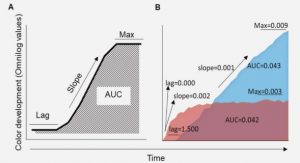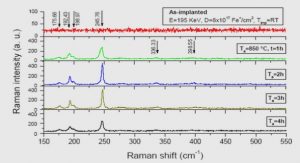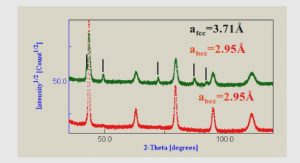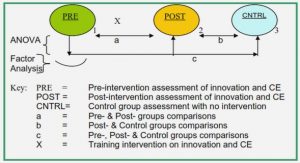Get Complete Project Material File(s) Now! »
Metallic nanowire networks: Synthesis, Fabrication and Physical Properties
Synthesis of Metallic Nanowires (MNW) and Network Fabrication
The growth of metallic nanowires has already been described and reported by many groups.[32– 40] Several MNWs, such as silver, copper, gold, or cupronickel, have been synthesized in solution and deposited in the form of networks with promising properties. However, silver nanowire (AgNW) networks have so far been the most commonly studied. This stems from both the excellent physical properties of bulk silver, which is the most electrically conductive material at room temperature, and has rather straightforward synthesis scalability and reproducibility.
MNWs are mainly synthesized using the polyol process, but other methods, such as hydrothermal synthesis, may be preferred, notably for copper-based NWs.[44–46] In the case of the polyol process, AgNWs are usually synthesized by reducing the Ag nitrate in the presence of polyvinylpyrrolidone (PVP) in ethylene glycol.[34,47,48] PVP is the most widely-used capping agent and is responsible for anisotropic surface passivation. It is preferentially adsorbed along the (100) surfaces of the growing AgNW while the (111) surfaces are free to grow. The lateral growth is then prevented thanks to this anisotropic adsorption. Figure 1a shows a typical AgNW observed by Transmission Electron Microscopy (TEM) revealing the presence of an amorphous thin layer (mostly seen as the PVP shell) surrounding the (100) AgNW surfaces. This type of synthesis generally yields MNWs with a typical diameter ranging from 20 to 150 nm and lengths from few to several tens of µm. The AgNW synthesis is a scalable process (gram-scale synthesis), which is now well mastered. Several industrial providers such as “Blue nano”, “ACS Materials”, “Cambrios”, “BASF” (former AgNW activity developed by “Seashell Technology”), have already proposed commercial MNWs in solutions, specifically AgNWs and to a lesser extent CuNWs.
MNWs can be dispersed in many solvents, usually water or alcohols. Inks can be formulated to be suitable for various solution-based processing techniques in order to manufacture films with randomly-oriented NWs. Of these methods, spin coating,[49,50] spray coating,[51] drop casting,[52– 54] doctor blade casting,[55] dip-coating,[56] Mayer rod coating,[57–59] screen printing (serigraphy),[60,61] vacuum filtration[41,62,63] or brush coating,[64,65] are the most reported in the literature. Figure 1b shows a typical, dense AgNW network sprayed on to a polyethylene naphthalate substrate (PEN). The network is dense enough to provide many electrical percolating pathways, while the free areas between the metallic NWs allow the light to go through, and the resulting film to exhibit high optical transparency.
Figure 1. a) TEM image of a single AgNW showing the amorphous layer surrounding the NWs. This shell is assumed to be PVP. b) Plane-view SEM picture of an AgNW network. c) Typical flexible TE fabricated with MNW network. d) Flexible device (touch sensor) using MNW-based flexible TE.[67]
As pointed out by Scardaci et al.[51] or Cao et al., [43] either for MNWs or carbon nanotubes (CNTs), the choice of network fabrication method, as well as the experimental conditions, has a strong influence on the properties of the network. A trade-off often needs to be considered. For instance, for the spray method, the substrate should be heated high enough to allow the droplets to dry fast and prevent coalescence into larger droplets before drying. However the heating temperature should be adapted to the type of substrate, remaining moderate for polymer substrates for example.[51,66] In addition, certain techniques, such as spin coating or vacuum filtration, can only be effective for fabricating films on small area substrates. The spray technique is compatible with up-scaling, as well as being cheap and providing fast deposition of uniform MNW films on either rigid or flexible substrates (see Figure 1c-d). This is why most of the samples studied within the frame of this thesis have been prepared using a spray-coating set-up (ExactaCoat Benchtop Ultrasonic Spraying System, from Sono-Tek Corp.). However, one possible limitation arises from the difficulty of spraying long MNWs as they tend to break in the ultrasound nozzle or become stuck and clog the spray.
Properties of individual MNWs: size effects
Individual MNWs have very good electrical and thermal conductivity: silver is the most efficient electrical conductor, and gold, copper and even alloys such as Cu-Ni are also highly conductive. Even for small NW diameters, i.e. typically from 20 to 150 nm, the electrical conductivity is still very high. It decreases for diameters approaching the mean free path of electrons in bulk metals (about 40 nm for Ag or Au). Bid et al., for instance, measured at both low and room temperature the electrical resistivity of AgNW and CuNW.[68] These authors showed that when the NW diameter approaches the mean free path of electrons in the bulk material, the electrons surface scattering increases, leading to an increase in NW resistivity. Such a behavior was experimentally demonstrated and can be well described by Equation 1.1:[68]
With the resistivity of silver nanowire, the resistivity of bulk silver, DNW the nanowire diameter and ʌ the electrons mean free path. For instance, at room temperature, the electrical resistivity of a 30 nm diameter AgNW is 25% higher than for a diameter of 100 nm.[68] A similar trend is observed for CuNWs. However, this increase still appears reasonable for efficient integration, but could play a negative role when stability under high current density or rather high temperatures is required.[50]
From an optical point of view, a low diameter is beneficial for increasing the transmittance and decreasing the proportion of photons scattered by the NW.[69–71] Larger NW diameters are also associated with higher roughness, which often needs to be reduced for most optoelectronics devices, especially when very thin layers are concerned, such as in organic solar cells or OLEDs for instance.
Long MNWs help to reach electrical percolation at a lower network density (the latter is simply defined as the number of AgNWs per unit area). Indeed, as described in §1.1.3, the critical density, associated with the percolation occurrence probability of 50% and defined as nc, is inversely proportional to the square of the NW length. Hence, the use of high aspect ratio nanowires appears of interest since it allows a decrease of the number of resistive junctions involved in the electrical percolating network. Meanwhile, it increases the optical transparency of the network. Several studies recently reported major advances in the synthesis of very high aspect ratio (>1000) silver nanowires, suitable for fulfilling the industrial criteria of optoelectronic performances. However, it is rather challenging trying to maintain the integrity of very long NWs as they tend to break during the dispersion or deposition processes (especially when ultrasounds are used). Finally, a compromise needs to be found for the choice of the most suitable NW dimensions in relation to target applications. The ability to control the dimensions of nanowires (both average values and size distribution[76]) during synthesis remains a crucial issue and a challenge for future prospects for metallic nanowire networks.
Influence of interconnections and network density on the optical and electrical properties
The interconnections between MNWs play a key role, strongly influencing the properties of the network.[77–79] Just after deposition, the electrical resistance in the MNW network is often high. This can be attributed to the non-efficient contacts between NWs, and to the presence of organic residue such as the PVP shell at the contact points. This feature is similar to CNT based networks, but MNWs appear much more prone than CNTs to creating efficient interconnections: the network’s electrical resistance can be drastically reduced thanks to methods such as thermal annealing (see Figure 2a and Figure 2b),[42,80] chemical treatments,[49] laser sintering,[81] light-induced plasmonic nano-welding (see Figure 2c and Figure 2d),[82,83] or mechanical pressing (see Figure 2e and 2f).[54] Many papers report that such methods can lead to a dramatic decrease in sheet resistance from 104 or 105 to about 10 Ω sq-1.[42,50,54] A decrease of this type can be attributed to the activation of surface diffusion phenomena, leading to local sintering at the junctions between neighboring NWs. Bellew et al.[78] and Nian et al.[79] have recently been able to measure the electrical resistance of NWs and certain individual junctions after post-deposition treatments. Both investigations show that for optimized networks, the junctions do not seem to predominantly impact the network’s electrical resistivity any more.
Figure 2. a,b) SEM images of an as-deposited sample (a) and of a specimen annealed for 10 minutes at 300 °C (b). Scale bar is 1 µm.[42] c,d) TEM images of silver nanowire junctions before (c) and after
(d) optical welding. Scale bar is 50 nm. Reproduced with permission.[83] e,f) SEM images of AgNW electrodes before (e) and after (f) mechanical pressing at 25 MPa for 5 s.[54]
Network density, defined as the number of nanowires per unit area, is also of primary importance. It may also be useful to consider the areal mass density (amd) simply expressing the metal mass per unit area in mg m-².[41,50] This parameter has a strong influence on the optoelectronic properties of the network. For instance, optical transparency often appears to decrease linearly with network density,[69,84] while sheet resistance Rsh is linked to the density as follows: where nc is the critical density and γ is the percolation exponent.[85] This is well-demonstrated by the experimental measurements depicted in Figure 3a. Increasing the network’s amd leads to a linear decrease in optical transmittance and a power-law decrease in electrical resistance (linked to a non-linear increase in efficient electrical pathways available through the whole network). Moreover, such experimental measurements can be well fitted by relatively simple modeling approaches.[50] As shown first by De et al. and then by Lagrange et al., percolation theory dominates the electrical behavior of networks associated with low density.[41,50]
It is necessary to search for a trade-off in network density. A network that is too sparse does not provide enough efficient pathways for electrons in the network to reach low sheet resistance values, while one that is too dense conducts efficiently but becomes too opaque. For many applications, network density should lead to high light transmittance (~90%), associated with low electrical resistance (~10-100 Ω sq-1) through the whole electrode area. To efficiently assess the effects of network density, figures of merit (FoM) are often used. A classic FoM for considering TE performances is Haacke’s FoM defined as: = 10 (1.3) where Tr is optical transmittance (often considered at 550 nm) while Rsh is sheet resistance.[86] This FoM is used to assess performance of a TE specifically for comparing different TEs, with a higher value corresponding to a better trade-off between transmittance and sheet resistance. For the AgNWs presented in Figure 3a, the FoM is bell-shaped. The best amd appears to be close to 130 mg m-².[50] This value depends on how the network is manufactured, and the dimensions of the MNWs. Other values have been reported in the literature, for instance 40 mg m-² by Celle et al.,[14] (in supplementary material section), 70 mg m-² for De et al.,[41] and 331 mg m-² for Göbelt et al., who used AgNWs of rather large diameters and small lengths.[87] Most of these values show that considering an amd range of values of 40-200 mg m-² (compatible with the literature[50,79]) corresponds to an equivalent material quantity of a homogeneous thin Ag layer that is 4-20 nm thick. To obtain similar optoelectronic performances, the usual thickness range associated with conventional ITO-based electrodes is 150-200 nm.[88] Given that In2O3 represents roughly 90 wt% in ITO, the corresponding indium amd range is roughly 750-1050 mg m-², much higher than the required Ag amd in AgNW networks. Knowing that the price per unit mass of In and Ag are of the same order of magnitude, this shows that integrating MNW networks as TEs in devices can be an interesting cost-efficient replacement for the conventional ITO or Ag grids used in solar cells.[87,89] Therefore regarding the costs associated to raw materials, AgNWs appear more competitive than ITO. Moreover, ITO is fabricated using an expensive high vacuum physical phase deposition process, whereas AgNW-based electrodes are compatible with low-cost solution-based deposition processes. It is actually difficult to compare fairly the final overall costs for various processes including all production costs (capital expenditure, operating expense, raw material prices, etc.). It is beyond the scope of this thesis, however some information dedicated to this specific point is available elsewhere.[90]
Figure 3. a) Dependence of the experimental values of optical transmittance, electrical resistance, haze factor, and Haacke’s FoM of AgNW networks versus their areal mass density (amd). The continuous lines are associated with fits extracted from physical modeling by Lagrange et al.[50] b) Transmittance versus sheet resistance diagram for comparison between various TCMs: ITO,[3,41]
graphene,[3,91–93] CNTs,[3,41,94] CuNWs,[38,57,82,95] Copper nanothrough,[96] AgNWs,[3,50,54,97–99] FTO.[100]
The dashed lines correspond to different iso-values of Haacke FoM: 200, 100, 50, 10, 1 with units 10−3 Ω−1. c) Comparison of optical total transmittance in the UV-VIS-NIR region for a bare glass substrate (blue), AgNW network (black) and fluor-doped tin oxide (FTO, in red) which exhibit similar sheet resistance of about 11 Ω sq-1. MNW networks are still transparent in the NIR region. d) Calculated Haacke FoM (from experimental values) of AgNW networks versus their experimental haze factor. The dashed line is associated with a fit extracted from physical modeling by Lagrange et al.[50] Areas of interest are roughly represented for two applications which require either low or high haze factor values.
Figure 3b shows the characteristics (Tr vs Rsh) of several transparent conducting materials including ITO, FTO (Fluorine doped Tin Oxide), CNTs, graphene, copper and silver nanowire networks. The discontinuous lines plotted in Figure 3b are associated with several iso-values of the Haacke FoM. Obviously, the target is in the top left corner of Figure 3b. By using adequate post-deposition treatments, many research groups have reported metallic NW networks with optical transmittance of 90% and sheet resistance of less than 10 Ω sq-1,[50,79] showing that metallic nanowire networks can exhibit more competitiveness than other TCMs in terms of trade-off between transparency and electrical performances. Finally, when compared to other conventional TCMs, MNW networks benefit from interconnections that enlarge the wavelength range for which the optical transparency is very high. For instance, Figure 3c shows the optical transmittance of an AgNW network and one typical Transparent Conductive Oxide (TCO), i.e. Fluor-doped Tin Oxide (FTO). Both films have similar physical properties, a sheet resistance of 10 Ω sq-1 and an optical transparency of 90% at 550 nm once the glass substrate background has been removed. An interesting feature for the AgNW network is the high transmittance values in the near Infra-Red region (NIR) which is a relevant asset for certain applications, especially photovoltaic systems.
Light scattering of MNW networks
Another important parameter which needs to be considered for applications where TEs are involved is the haze factor (or haziness). This is an optical parameter that quantifies the amount of transmitted light scattered by the TE and is simply defined as the ratio between the diffuse part and total transmittance. Requirements regarding haziness depend greatly on the applications. For instance, touch panels and transparent heaters placed on windscreens or visors need a low haze factor (typically below 3%) to ensure comfort for the human eye, and to prevent blurred viewing, while the performance of solar cells is enhanced by a high haze factor associated with the TE used.[101,102] Scattering light enhances the optical path length of photons in solar cells, increasing their probability of being absorbed by the active area of the cell and then generating charge carriers.[103]
The haziness of MNW networks has thus been the subject of several studies.[69,70] Experimental data show a linear increase in haze factor with network density, as is clearly shown in Figure 3a. In a similar way, the haze factor decreases in a linear manner as Tr increases.[50,69,84] Moreover, the haze factor depends significantly on the dimensions of the NW. For instance, Araki et al.[69] showed that using very long AgNWs (20-100 µm) helps to decrease the haze factor, in agreement with Chang et al.[104] In the same vein, Preston et al.[70] observed that AgNWs with higher diameters lead to a higher haze factor in the visible range.
Unfortunately, the literature has not yet provided many detailed investigations capable of explaining these tendencies. Interestingly, Khanarian et al. reported that AgNW diameter appears to be the most important parameter morphologically, determining both the transmission and haze of AgNW networks.[105] As discussed below, MNWs can be mixed with other materials to produce hybrids. A good example for varying haziness is the controlled incorporation of ZnO nanopyramids into an MNW network film which makes possible highly tunable control of the scattering properties of this type of TE.[106]
Figure 3d shows the behavior of the AgNW networks’ FoM against the haze factor. Each experimental point is related to one specific value of areal mass density. The FoM is bell-shaped. Figure 3d can be seen as a guideline for selecting the most appropriate density value compatible with the target application, as well as the associated constraints regarding the haze factor.[50] Defining a new FoM taking into account the haziness of the MNW-based TCM studied would be very useful for selecting the appropriate physical parameters for each specific application.
Table of contents :
Introduction
Chapter 1. Introduction to transparent electrodes based on metallic nanowire percolating networks
1.1. Metallic nanowire networks: Synthesis, Fabrication and Physical Properties
1.1.1. Synthesis of Metallic Nanowires (MNW) and Network Fabrication
1.1.2. Properties of individual MNWs: size effects
1.1.3. Influence of interconnections and network density on the optical and electrical properties
1.1.4. Light scattering of MNW networks
1.1.5. Flexibility of MNW Networks
1.1.6. Stability issues and hybrid nanocomposites based on MNWs
1.2. Integration of metallic nanowire networks for different applications
1.2.1. Photovoltaic Applications
1.2.2. Lighting (Organic LEDs)
1.2.3. Transparent Film Heaters
1.2.4. Smart Windows and Displays
1.2.4.1. Electrochromic and Polymer-Dispersed Liquid Crystal Devices
1.2.4.2. Touch Screens
1.2.5. Electromagnetic Devices
1.2.5.1. Electromagnetic Shielding
1.2.5.2. Radio Frequency Antennas
1.3. Concluding remarks
Chapter 2. Optimization of the AgNW networks electrical performances
2.1. Impact of thermal annealing and acid treatment
2.1.1. Thermal annealing and acid treatment: protocols and set-up
2.1.1.1. Thermal annealing set-up
2.1.1.2. Acid treatment protocols
2.1.2. Description of the results
2.1.2.1. Impact of thermal annealing and acid treatments on Seashell AgNWs
2.1.2.2. Impact of thermal annealing and acid treatments on Liten NWs
2.1.2.3. Other optimization techniques
2.2. Nano-characterization of the phenomena taking place at the NW-NW junctions
2.2.1. Morphological impact of thermal annealing: nanoscale characterization
2.2.2. Morphological impact of acid treatment: nanoscale characterization
2.2.3. Exploration of the internal structure of NW-NW junctions: preliminary results
Chapter 3. Description of the modelling tools developed during this thesis
3.1. Brief introduction to the percolation theory
3.2. Generation of random networks via Matlab-based Monte Carlo simulations
3.3. Electrical and thermal simulations using Comsol
3.3.1. Network geometry exportation from Matlab to Comsol
3.3.2. Materials properties used in the model
3.3.3. Boundary conditions for electrical simulations
3.3.4. Boundary conditions for thermal simulations
3.3.5. Geometrical meshing of the specimen
3.3.6. Calculation of the network resistance
3.3.7. Comsol-based simulations: positive and negative aspects
Chapter 4. Electrical distribution in AgNW Networks
4.1. The case of low density networks: geometrical quantized percolation
4.1.1. Introduction to geometrical quantized percolation phenomenon
4.1.2. Analysis of quantized percolation using lock-in thermography
4.1.2.1. Lock-in thermography technique
4.1.2.2. Experimental results
4.1.2.2.1. Activation and detection of efficient percolating pathways (EPPs)
4.1.2.2.2. Discussion about partially highlighted EPPs
4.1.2.2.3. Influence of the electrode geometry: lighting rod effect
4.1.3. Impact of the AgNW diameter on geometrical quantized percolation
4.1.4. Introduction to “anti-percolation” phenomenon
4.1.5. Concluding remarks
4.2. The parameters that influence the electrical homogeneity and stability of AgNW networks
4.2.1. Impact of the network density on the electrical homogeneity
4.2.1.1. Electrical and thermal mapping of AgNW networks with different network density
4.2.1.2. Correlation with simulation models
4.2.2. Impact of the junction efficiency on the electrical homogeneity
4.2.2.1. Experimental analysis using lock-in thermography
4.2.2.2. Correlation with simulation models
4.2.3. Optimization and failure dynamics of AgNW networks under electrical stress
4.2.3.1. Evolution of the electrical behavior of standard AgNW network under electrical stress
4.2.3.2. Description of the mechanisms involved in the electrical breakdown of AgNW networks at high voltage
4.2.3.3. “Life in the crack”
4.2.4. Conclusion and outlooks
Chapter 5. Stretching properties of AgNW-PDMS composites: preliminary results
5.1. Fabrication, properties and applications of AgNW-PDMS stretchable conductors: short state-of-the-art
5.2. Protocols
5.2.1. AgNW-PDMS composites preparation
5.2.2. Stretching tests presentation
5.3. Impact of the NW density on the stretching properties
5.4. In situ characterization of the mechanical deformations
5.5. Outlooks
Chapter 6. Applications
6.1. AgNW-based transparent film heaters (TFHs)
6.2. AgNW-based antennas and transmission lines: preliminary attempts
6.2.1. Antenna fabrication and measurement procedure
6.2.2. Performance of AgNW-based antennas
6.2.3. Transmission lines
6.3. AgNW networks for transparent electromagnetic shielding
6.3.1. Measurement of the shielding effectiveness of AgNW networks
6.3.1.1. Description of the experimental setup
6.3.1.2. Impact of the AgNW network density on the shielding properties
6.3.1.3. Impact of environmental ageing, thermal annealing, substrate, and deposition technique
6.3.1.4. Comparison with thin silver films and thin silver wire mesh screens
6.3.2. EM shielding outlooks
Conclusion and future works






